One pax succeeded and another attempted to leave the 2nd Annual Mt. Mitchell Heartbreaker 50-miler without a broken heart. Unlike some other people, both also left without broken bones.
About the race
The race bills itself as an “extremely scenic tour” of the tallest mountains on the East coast. You run up and down three peaks that exceed 6,000ft elevation. The first two, Green Knob and Mt. Mitchell, also involve 3,000-ft climbs and descents in fairly short stretches of distance (~3-4mi up, then same down). As such, you also get to experience all four seasons of weather in a day. Both the climbs and weather variability make properly preparing for the race pretty tricky.
For an idea of what “extremely scenic” means, check out their promo video:
The 50-miler starts at 5:30am, which meant we were up at the witching hour of 3am to get ready and leave. Banjo was good at talking through reminders of, “Did you get this, did you get that?” which for someone as quiet as YHC was very helpful.
He ran into Coco from Churham at the start.
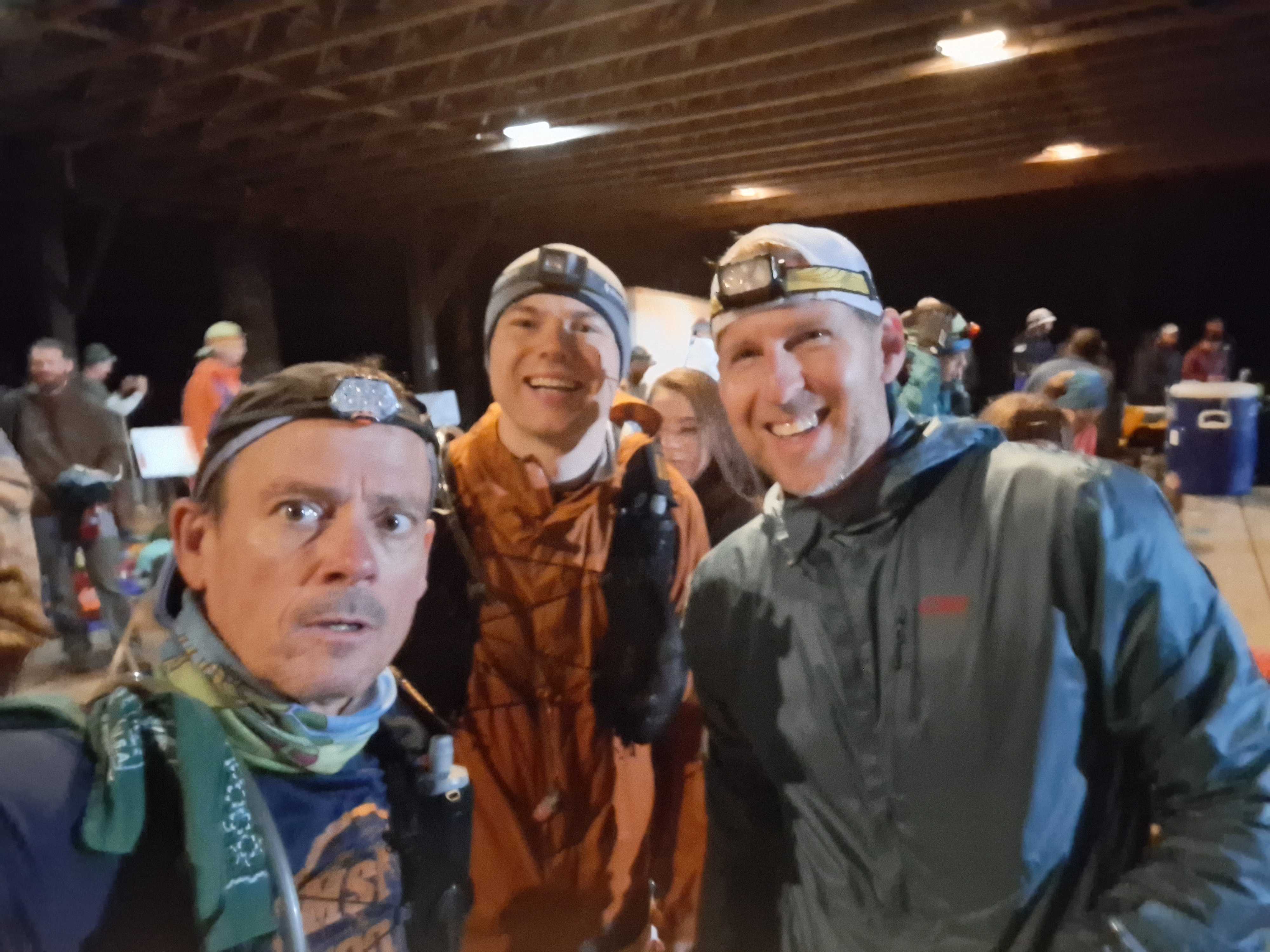
Map
The event had a really great tracking system, including several apps and maps to help you see where you were. However, I had a hard time finding a Strava route or simple elevation profile.

Station-by-station guide
The race has the following aid stations, some of which have accompanying cutoff times. In the 50-mile, you have a total of 16.5 hrs, which averages out to roughly 19:40 min/mi pace. But that is a bit deceptive, because you won’t be doing that pace for hardly any of the race, due to its up and down nature. This, in turn, can make planning what pace you need to hit to reach cutoff times more difficult.
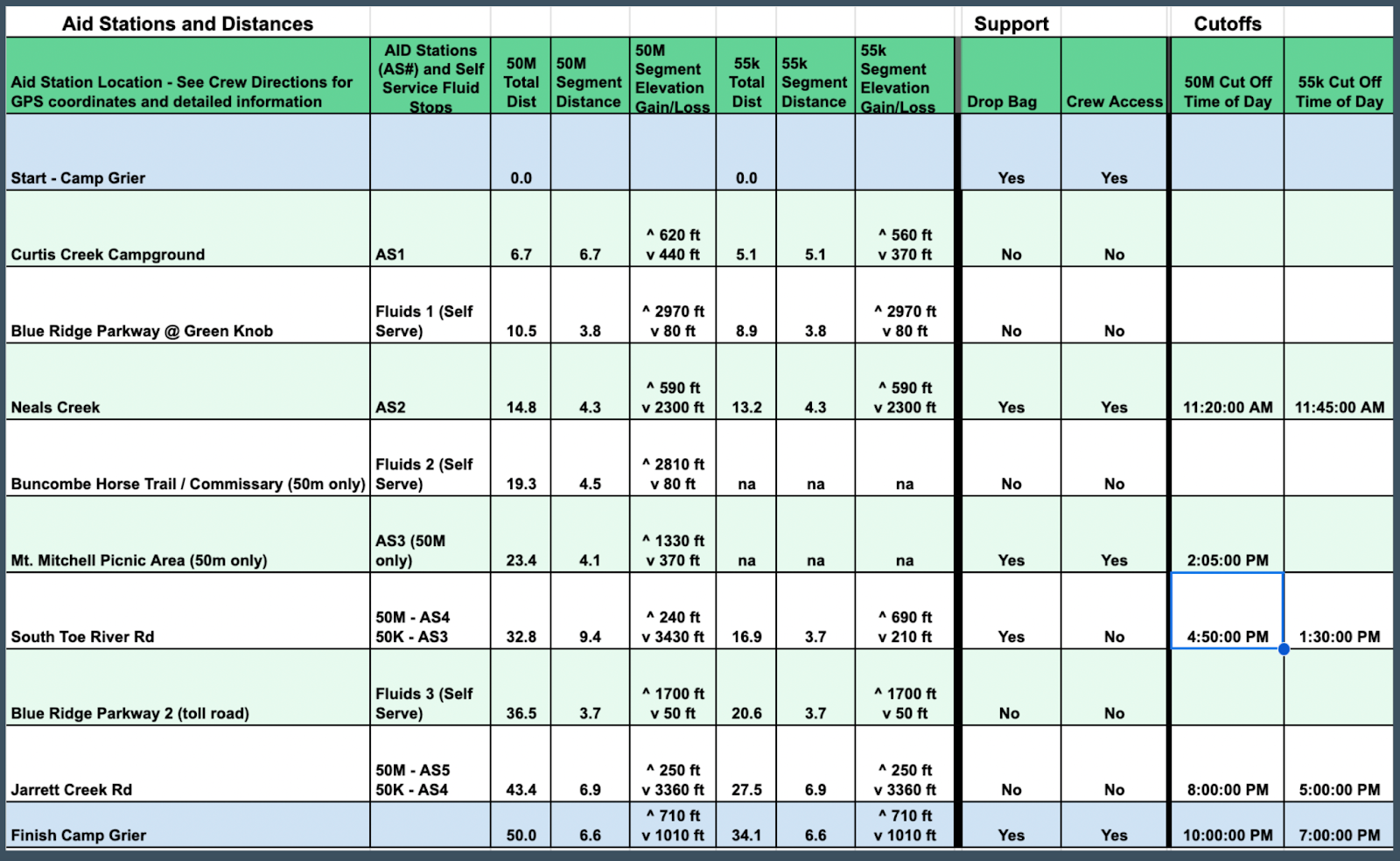
To Curtis Creek Campgrounds
The beginning of the course was perfect, gently rolling on mostly MUT and very runnable for nearly 7 miles. After a gloomy forcast of low temps and rain, we were also relieved to find the weather mostly clear, some patches of stars even, and a lovely low-50s temp. We tried to keep the pace even at around 10 min/mi, which placed us in the middle of the pack and also gave us the chance to chat with several people.
The miles flew by, prompting me to think that my watch must already be miscalculating (been having some reoccurring issues with that). One thing that everyone seemed to agree on was that it’d be best to complete the race in ~14 hrs, so as not to need to get back out your headlamps. Not sure what it is about trail runners, but no one likes headlamps.
The aid station was fully stocked, but neither of us needed fuel at this point, so we just replenished water and quickly moved on.
To Green Knob at Blue Ridge Parkway
The first climb of ~3k ft in ~3.5 mi took me completely by surprise. It was way more technical than I thought it would be…very difficult at times to figure out foot and pole placement. And speaking of, quite a few racers were not even using trekking poles! Besides the ones who had quads the size of my torso, I have no clue how they did it. I would have been too worried about burning out my legs so early in the race.
The fluids-only aid station also helpfully had a bonfire to warm up your fingers…at this elevation, it was pretty cold, but with the promise of sun soon and most of the first climb behind us, we were pretty confident to move ahead. Some other runners, however, were already talking about cramps from the climb.
To Neals Creek
After leaving the Parkway, you climb another ~600 ft to the summit. This was timed almost perfectly with sunrise, and many people stopped to take some photos. The sunlight was streaming through clouds, and in many places, it looked like pockets of lakes beneath the peaks. Very silent, very serene.
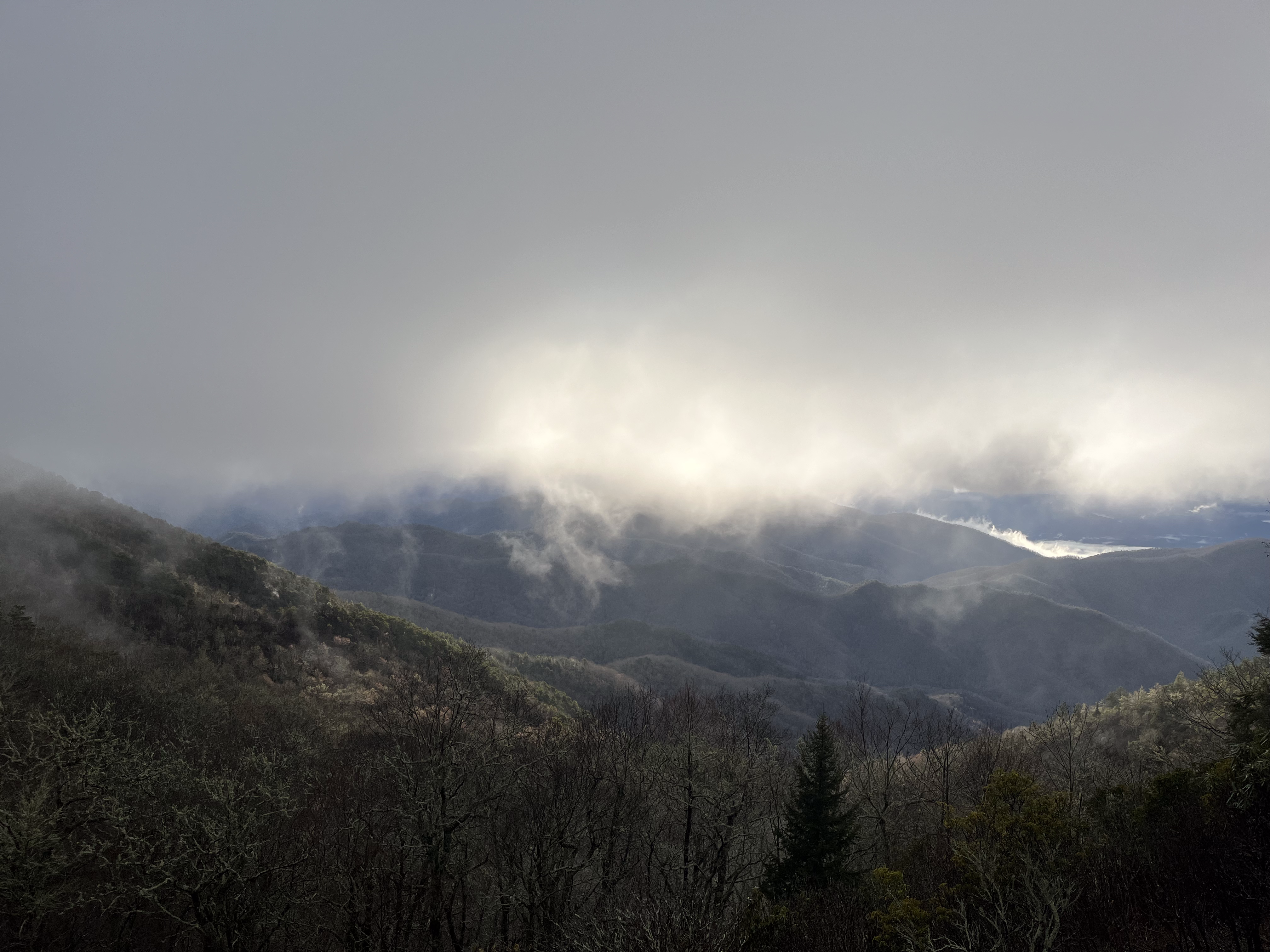
Knowing that I had a downhill for the next several miles, and already having quite a bit of time (the cutoff for the next aid station was 3+ hrs away still), I even sat down on a rock to eat a bit and take a selfie…my only one of the day, as it turned out.
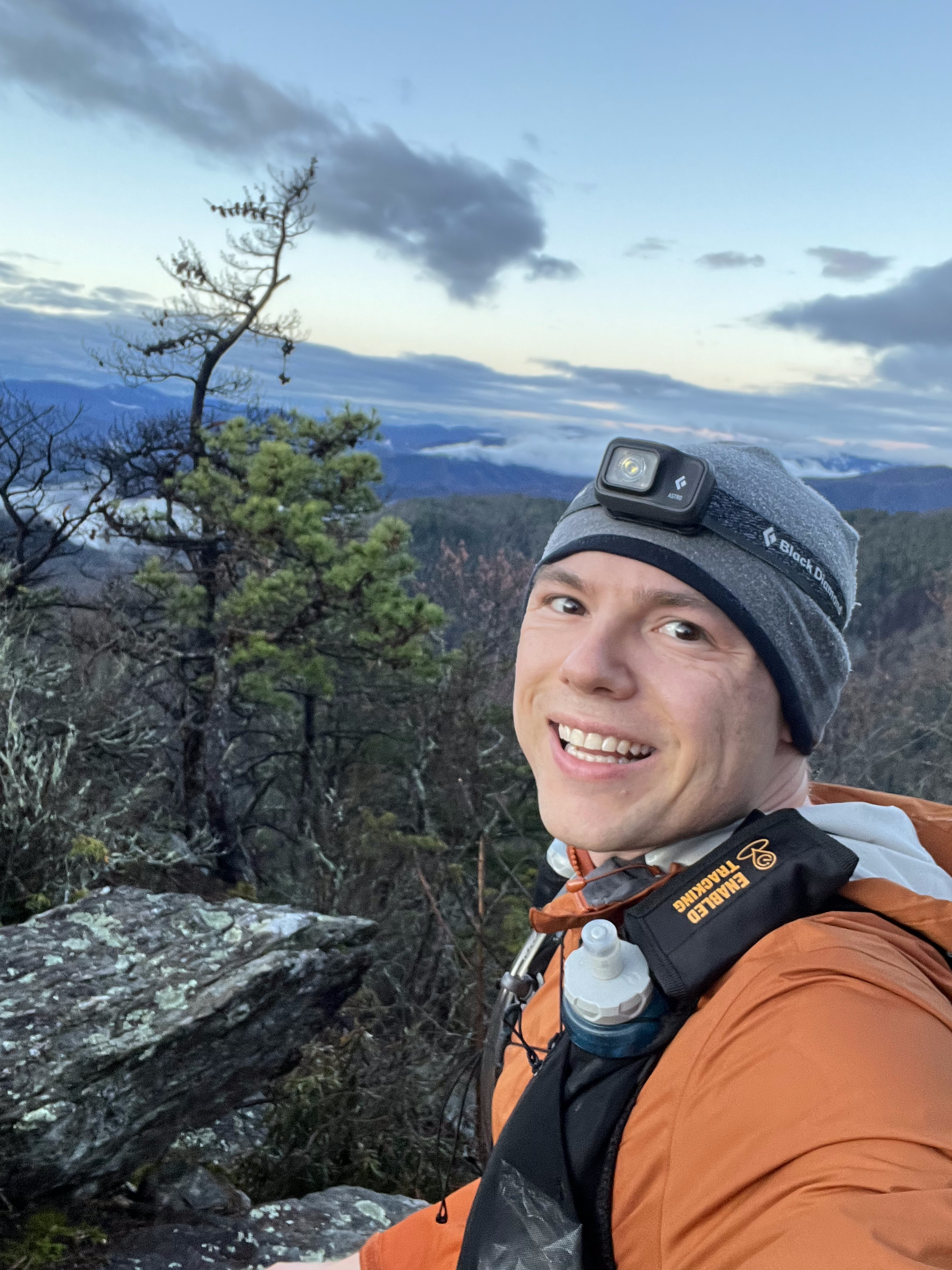
Counting on the downhill to make up time proved to be a mistake. The course was so steep, rocky, and slick from the rain of the previous night that it was not as runnable as I hoped. Several times I found it easier just to sit on the rocks and slide down. The poles, while helping me stabilize and safely descend, also slowed me down and changed my gait which kept psyching me out. The times I ran best were the times I didn’t use my poles, and just let momentum propel me forward…but then I’d get worried about tripping and injuring myself early. My knees, which I had just rehabbed enough to run ~6 weeks ago, also started complaining at this point.
It was also still pretty much single-file at this point in the race, which added another dynamic of passing or be-passed and the etiquette that surrounds it. Many times, you keep trading places, as some people slow down at different parts due to their comfort or fatigue levels, but then make it up later. This made it difficult for me to assess how I was doing in terms of other racers, but I figured I was fine in terms of time elapsed.
I knew that at the bottom at the Neals Creek station, I could drop down to the 55k. And the thought of having to do two more similarly steep descents worried me way more than two more climbs. Time cutoffs didn’t worry me, as I made it to the aid station 1.5+ hrs ahead. Despite the beginnings of knee pain, I was pretty confident I could complete a 55k, and so I wondered if that would be the best course of action.
But I decided that I had come to run Mt. Mitchell, and the 55k course skips that. Plus, I figured that I could drop at any aid station if I really needed to. And I was honestly in a pretty good mood and enjoying the race, despite being way undertrained for it. So I grabbed some water and kept moving, eating while walking on some of the gentler inclines.
To Buncombe Horse Trail
This stretch featured another ~3k ft climb in ~3 mi, and was pretty slow-going to the point that I had several longer conversations with fellow racers who seemed to need the distraction. Personally, I felt surprisingly good at this stretch of the race: the change to a climbing motion actually helped work out my knee pain after such a painful descent. The worst part about this stretch of the climb was that I felt the temperatures plunging.
I had on a thin long-sleeve (Duck Donuts Dash), a t-shirt (Hell’s Bells bright orange), and a lightweight rain jacket; a running beanie; shorts; and long socks (the sunset-colored MFRFSP, which also got a lot of compliments incidentally). I also had running gloves, but wasn’t wearing them at this point. I probably should have stopped to put them on before reaching the aid station, but people kept assuring me the station was less than a mile ahead (spoiler, it wasn’t).
During this stretch was also the only time that I drank both of the Salomon bottles completely. I had a backup 2L water pack, so I wasn’t worried about running out of water. But interesting to note that despite the cold, the climb was difficult enough that I kept needing water. As soon as I got to the aid station, I also chugged another bottleful…which lead to brainfreeze because the water was so cold!
The aid station was just water and was not pleasant. It was sort of in a wind tunnel, which made it even colder. They didn’t have a bonfire, unlike the first fluids-only. Also, at this point, I started wondering about time.
I had printed out and laminated the aid station card, but had accidentally left it in the car. I thought I remembered that the next station at the top of Mt. Mitchell had a 1:30pm cutoff (basically halfway through your time for halfway through the distance), and it was already 11:50am. So I thought I had only ~100 or so min to make it 4 more miles up the mountain, which I thought would be doable but difficult based on the past couple miles of ascent.
However, the volunteers assured me the cutoff was actually 2:30pm, said it was only 4 miles, and I should have plenty of time. They also said the same to several other runners who came in. I also knew the first mile or so of the next stretch was a fairly flat horse trail ridge, which was supposed to be runnable.
So after putting on my gloves, again I set off fairly confidently.
To Mt. Mitchell
A few of the people leaving the aid station wanted to walk and talk, but since this was the ridge, I felt like I needed to run it to bank some time, so I left a group behind.
The horse trail ended up being miserable. You are on top of a mountain. In a cloud. Dozens of streams flood the trail, leaving the sides icy and the rocks slick. The water is so deep, it covers half the logs placed as stepping aids. The mud is ankle-deep in places.
Many people tried to pick out the daintiest path, to keep their feet as dry as possible, but I gave up on that for the most part. Looking back, I wish I had run it a bit a faster given how cold it was, although with the mud it would have required more effort.
I was feeling pretty cold, but otherwise good, when I made it to the end of the trail. As soon as I started the climb, however, my right leg started cramping in tons of places. It took me by surprise. I think it was in part the sudden adjustment of running for a mile on flat ground to a climb again. At this point, I thought I had ~2 hrs to the next station ~3 mi away, so I sat down, took some base salt, ate, massaged my legs, and huddled up to try to get my hands and body warm again.
When I started again, the cramps were mostly under control. But the going was slow. At this point, you basically climbed up a rockbed stream. Sometimes the channel was so steep and slippery with mud, that I got out of it and crawled up through the woods on all fours…which I actually think was quicker.
I came across a guy who had also slowed down. He had already decided he was going to quit when he got to the top, but needed some encouragement to keep moving. So I hiked with him for the rest of the climb. At one point, he made a wrong turn down the trail. Although it did sort of seem like a trail, something felt off to me, so I kept stopping and looking around for blazes. He even pulled out his phone to check the Avenza app, which said we were still on the course. But at that point, he said that I could just lead so I turned us around and discovered we had, indeed, missed a turn that was partially obscured by a boulder.
I remember him making a comment that if I missed the cutoff due to that detour, he would feel really bad. But I laughed it off, thinking we still had 90 min to 2:30.
At that point, we hit the ropes course. I didn’t even know there would be ropes, and at first was pretty upset by it, because I don’t like heights. However, the courses were pretty short, and it was actually fun and a nice change of movement from what we had been doing. How to handle your poles while rope-climbing was a bit tricky, though.
At the summit, I was going to get out my phone to take a picture of the seal that says “This is the highest peak on the East coast,” or something like that, but my fingers were too numb and frozen, so I changed my mind.
We reached the aid station at 2:10pm. I started having a conversation with one of the volunteers about the next station. It was 9 mi away with a 4:30pm cutoff. Unless the next downhill went a lot better than the first, I doubted I could make that time, but I was planning to try…in part just because my dropbag was there. He was saying that I hadn’t made the cutoff, and I was saying, yeah I agree I likely won’t, and we were both confused for a moment until he explained that this cutoff was actually 2:05pm, not 2:30pm like the previous station had said.
I was caught off guard because it never occurred to me I would DNF from a cutoff perspective. There were several other people at this point, and some were upset at not being allowed to continue on. Some had even run the race last year, and missed this same cutoff by a similar amount of time.
At this point, I didn’t mind. I had kept moving throughout the whole thing. I had come to run Mt. Mitchell, and at least made it to the top. Plus, I still felt pretty good physically so am hopeful that I didn’t reinjure myself and have to rehab things for another 3 months.
They sent us to a van, where we waited about two hours for them to complete their sweeps and round up anyone else left on the course. It was a good chance to chat with how the other DNF’ers were feeling. I was surprised how many of them did not like my questions about what were the reasons they fell behind, what would they do differently, what races would they do next. Most of them seemed pretty deflated and depressed not to have finished. There was a lot of trying-to-stay-positive spin. Looking at the results overall, it seems like about a sixth of starters DNF’d.
I felt a little bad, because it was all a bit funny to me. Maybe I dissociated from myself a bit at this point, but I wasn’t upset by the DNF. I also realized that to me, it’s not just about getting a finisher’s medal. I could have done that by dropping to the 55k. But would that have really meant any more than a DNF? I was just glad to have been out there, and to have learned a lot in the process.
Rest of the race
These brief notes come from Banjo:
- To South Toe River Rd: More runnable than the first descent because it’s spread across a longer distance. But still rocky and slick, so you have to be careful.
- To Blue Ridge toll road: This last climb was not bad, significantly less climb and nothing as technical as the first two.
- To Jarrett Creek Rd: Another runnable downhill. You are just in finishing mode at this point. Good place to encourage and challenge other runners to push each other to finish.
As is classic Banjo, he came in with a group, knew everybody, and was meeting their families at the end. He made it in looking strong before it got dark around 8pm, about 2 hrs before the 10pm cutoff.
Post-race
We returned to a lovely dinner of salmon, broccoli, and potatoes that Carter (F3 Jazz Hands) prepared for us.
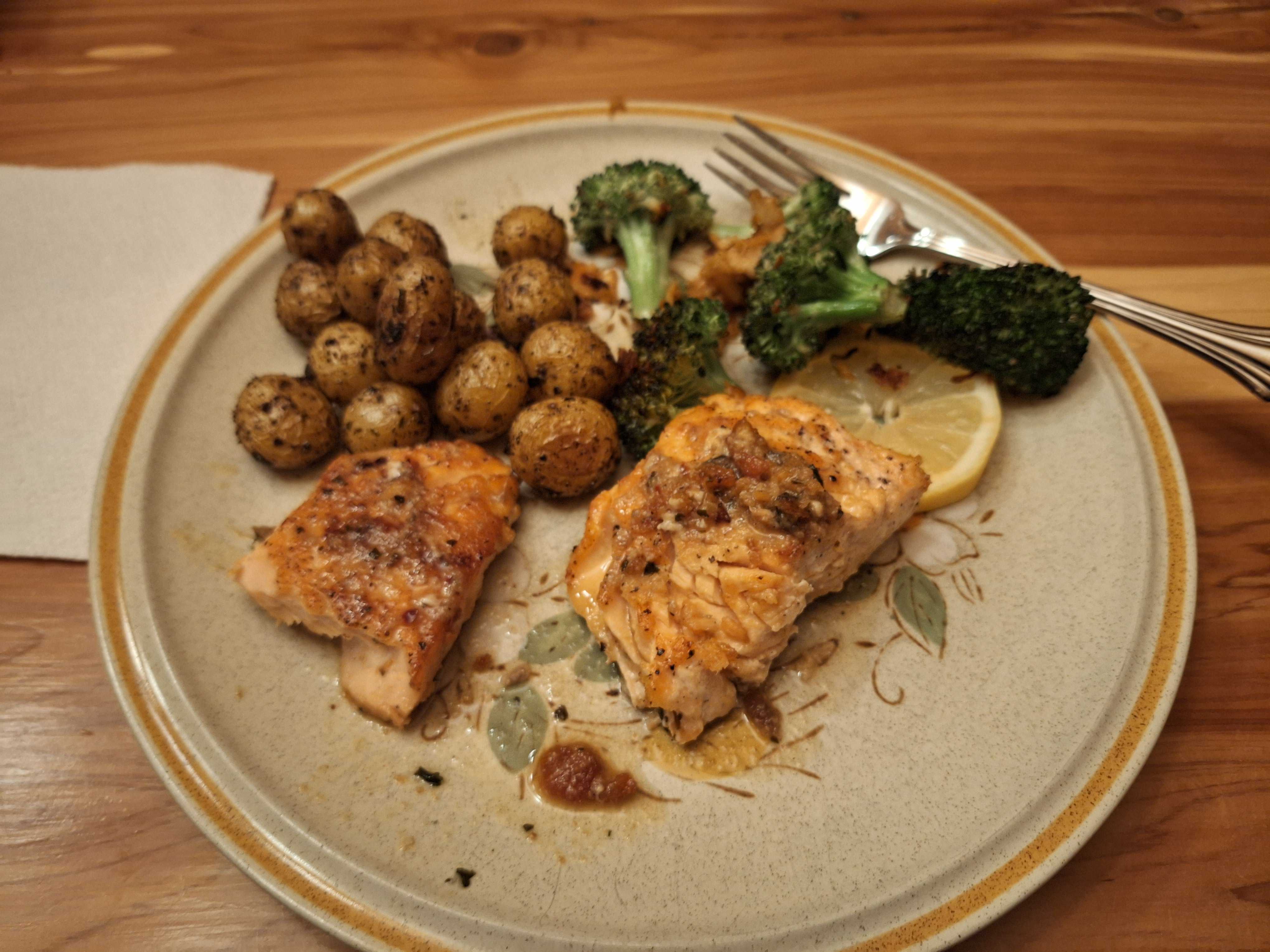
And despite not having finished the whole race, I still had one of my double-helping breakfasts the next morning.
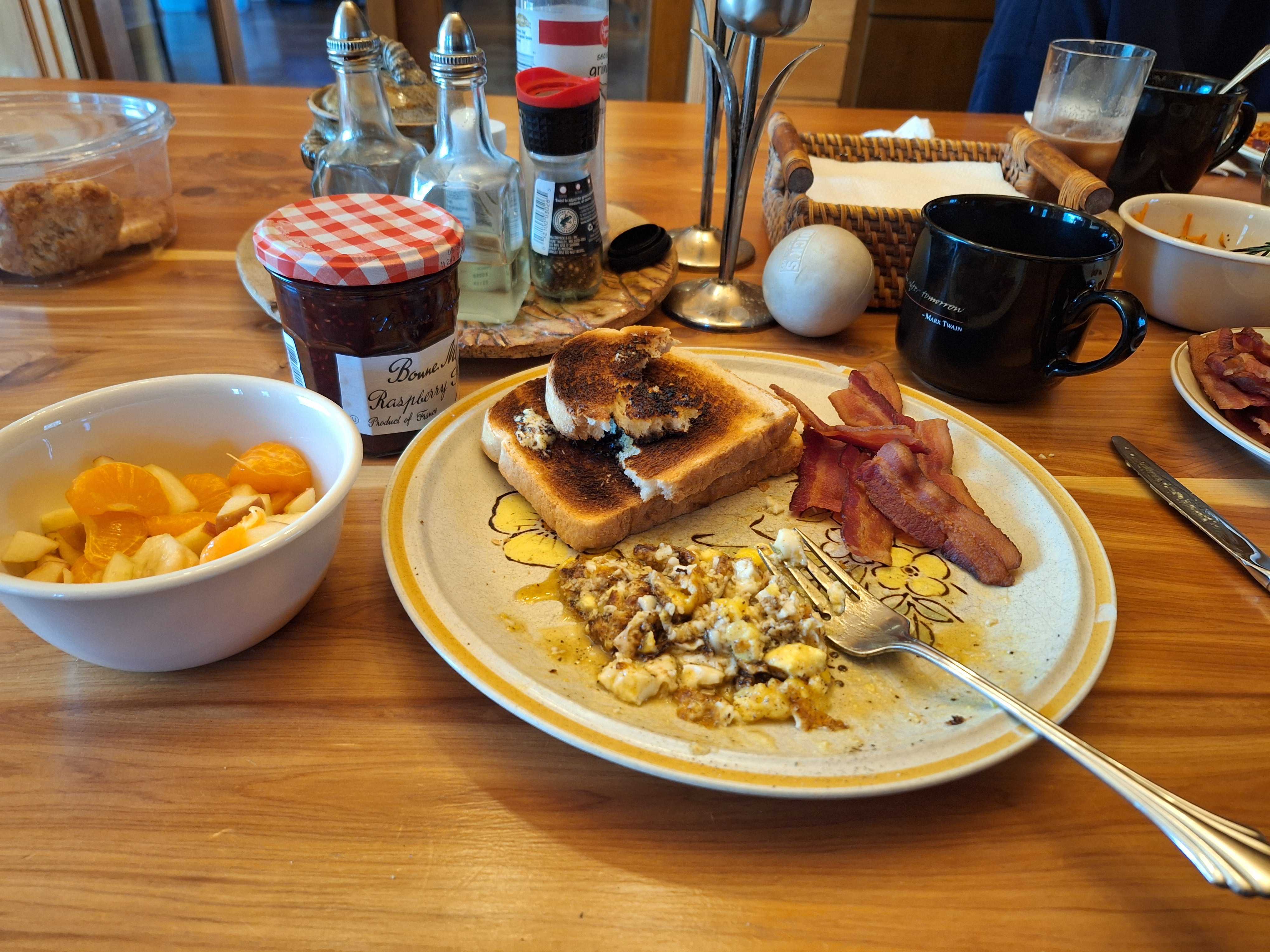
Overall, both of us have been pleasantly surprised by how well we feel post-race. Theraguns and menthol gel aside, a full night’s rest without too many aches and pains can do wonders.
After Action Review
I mentioned having learned a lot in the race, so I wanted to summarize that into things that went well, things that didn’t go well, and general lessons.
Went well
- My nutrition plan was way better for this than previous ultra’s I’ve done. I liked the rice ball recipe.
- Initial pacing at the beginning was good, not burning through all my energy.
- All things considered, I think my self-talk was pretty good. I might have let my mind wander a bit too much and slow me down, not sure.
Not well
- Tackling something as casually as I did…I let extenuating circumstances give me a sort of come-what-may attitude towards the race, and didn’t take it as seriously as I should have.
- Elevation preparation was seriously lacking. For some reason, I thought this would be more like the trail legs in SMR or like the South Mountain 55k, but it was way more difficult. Also needed more practice on downhills with trekking poles.
- Forgetting my cue cards and believing what other people told me regarding distances and cutoff times.
Lessons learned (?)
- Packing: I packed extra clothes in both my pack and the dropbag. I think I would have only needed one, mostly a change of socks. Warmer gloves in particular would have been good. I also had a bit more food than I needed, but that also meant I was able to give some away to people. Also, despite being packed to the brim, I didn’t notice the weight at all.
- Rehab: I have mixed feelings about where I was physically. I had only been able to run again about 6 weeks before this race. That made me more conservative about ramping up and general lack of readiness to attempt a race this difficult. However, I held up better than I anticipated, so I think the way that I rehabbed was ok.
- Training: My lack of prep for this race has reinforced how important it is for me to be more focused, strategic, and ruthless about saying no to things. I had a naive belief that the things we do in F3 would just be natural prep (e.g., MFRFSP, Hill Climb Challenge, the rucks and races and such). While these activities were certainly beneficial, you can get caught up in just doing what the group does vs. strategically participating only in events and AOs that align with what your training goals ought to be.
- Calling a race beforehand: If Banjo hadn’t signed up with me, I definitely would have dropped this race beforehand because of my rehab/readiness concerns. However, I’m still glad I did it and also don’t think I’ve injured myself. So I’m not sure if I really learned anything here.
- Calling a race during: I think I found out I could be pretty zen about just continuing on and telling myself I can drop if needed. I was fortunately in that by missing a cutoff, I didn’t have to make a serious decision about dropping or not before the second steep decline. I had intended to keep going, but maybe if I had, my knees would have rebelled. So I’m also not sure if I learned anything here, either.